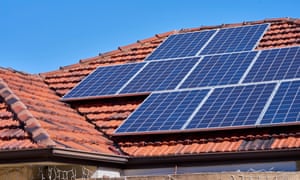A roadmap for an optimal electricity market suggests gas prices would need to remain at $4 to $6 per gigajoule
New gas-fired power is not essential for a grid increasingly based on renewable energy, and gas prices will need to stay low if it is to compete with alternatives, according to the government agency responsible for the electricity system.
The Australian Energy Market Operator (Aemo) has released a roadmap detailing what an optimal national electricity market would look like to 2040 if it was designed with a focus on security, reliability and the lowest cost for consumers.
Its integrated system plan, the result of 18 months consultation and analysis, describes a diverse system based on large-scale renewable energy and distributed power sources such as rooftop solar panels supported by multiple “dispatchable” sources. That’s power generation that can be called on whenever needed.
Aemo says the plan focuses on what is best for consumers and could deliver $11bn in net benefits.
The plan suggests solar panels backed by small batteries would provide between 13% and 22% of electricity by 2040. They would run alongside more than 26 gigawatts of utility-scale renewable energy – big solar and wind farms – that would be needed to replace 15-gigawatts of coal-fired generation that is scheduled to shut.
Support for these would come from between six and 19 gigawatts of dispatchable power, new systems designed to manage the more flexible grid and significant amounts of new transmission infrastructure. Renewable energy zones such as those proposed in New South Wales would be developed.
Audrey Zibelman, Aemo’s chief executive, said it was a “no regrets” plan for investment that could develop a modern, resilient, affordable power system. She said the issue for policymakers was no longer whether renewable energy was the best economic choice, but ensuring it was properly integrated into the grid.
“We’ve now shifted from wondering whether wind and solar are our cheapest resource to a new set of problems which is: how do we efficiently integrate these resources into the system so that we can take full advantage of the fact that for the first time in this industry we can use free fuel?”
The report nominates six potential sources of dispatchable power to support variable wind and solar. Five are needed: pumped hydro plants, big battery storage such as Tesla’s operation in South Australia, household-scale batteries, virtual power plants and demand-side participation, which offers energy users cash to cut consumption when needed.
The sixth, gas-fired power, is described as “a potential complement to storage”, but further investment in it is considered “less likely”. “New flexible gas generators could play a greater role if gas prices remained low at $4 to $6 per gigajoule over the outlook period,” it says.
The federal government, the chief scientist, Alan Finkel, and Scott Morrison’s National Covid-19 Coordination Commission (NCCC) have said gas generation was a critical part of the future energy supply as renewable energy replaces coal. The energy and emissions reduction minister, Angus Taylor, and the NCCC have both suggested a substantial expansion of the gas industry as part of the recovery from recession.
The push has been criticised on the grounds that gas is a fossil fuel, with recent studies suggesting it releases more greenhouse gas when burned than previously thought. A leaked draft report by a manufacturing taskforce appended to the NCCC recommends the government back fossil fuel infrastructure that would operate for decades and does not consider cleaner alternatives.
The government’s push for gas escalated as the price plunged from about $12 a gigajoule to about $4. Analysts have said future investment will depend on it settling at about $6 – and they have raised doubt over whether that was likely.
In a statement on Wednesday, Taylor said the government “strongly believes” gas would play an important role in balancing the grid.
Aemo’s plan lists several “actionable” projects to be prioritised over the next five years. They include an upgrade to a Victoria-NSW interconnector, a new connection between NSW and South Australia, a transmission upgrade between Snowy Hydro and southern NSW and augmentations to support a proposed renewable energy zone in central NSW. It backs a new interconnector between Victoria and NSW and the proposed Marinus Link between Tasmania and the Latrobe Valley.
The report warns: “If essential investments are delayed or aborted, domestic and industrial consumers will face increased costs and risks. On the other hand, if planning and investment occur in an uncoordinated way or is done inefficiently, customers and investors will experience the risk and cost of excess investment.”
Taylor said the report identified several investments likely to be required over the next two decades. He said more transmission was likely to be important but needed to make economic sense. “It is critical to avoid over-investment and ‘gold-plating’ of the network because it is consumers who have to pay,” he said.
Dispatchable generation was critical, the minister said, and the government would continue to support it through projects such as Snowy 2.0 and its underwriting program, which is backing gas and hydro developments.
The NSW energy minister, Matt Kean, said the report was a “strong tick of expert approval” for the state’s plans to build renewable energy zones.
Renewable energy provides up to 25% of electricity to the five eastern states and the ACT, which are linked though the national grid. An Aemo study in April found the country has the technical capacity to get 75% of electricity from wind and solar, and with the right regulations could occasionally reach this level within five years.

No comments:
Post a Comment